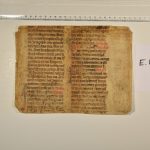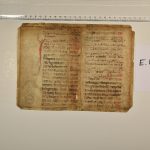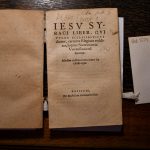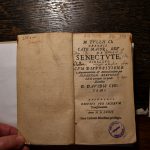The carrier consists of two volumes bound together. The notated manuscript fragment that once formed its binding, presumably detached in the second half of the 20th century, is kept in a box separated from the carrier book, together with the other detached fragments. The first volume of the colligatum represents the work of David Chytraeus (1531–1600), the Lutheran theologian from Rostock and student of Melanchthon, published in 1572 by the printing house of Jacobus Lucius (Transylvanus), who was born in Transylvania and worked in Rostock. Research on book history has shed light on Chytraeus’s numerous connections to Hungary (see e.g. Béla Holl, „Adatok David Chytraeus magyarországi vonatkozásairól,” [Beiträge zu den ungarischen Beziehungen von David Chytraeus], Acta Historiae Litterarum Hungaricarum 18 (Szeged, 1981: 55–63), and from his surviving correspondence we can learn that he personally sent books for Hungarian peregrines studying in Wittenberg (see more in András Szabó, „David Chytraeus és Magyarország,” [David Chytraeus and Hungary] in András Korányi ed., Megújulás és megmaradás, Dr. Fabiny Tibor egyháztörténeti professzor emlékére, [Renewal and preservation, in memory of Dr. Tibor Fabiny, professor of church history], Luther Kiadó, Budapest, 2009, 107–112).
In 1569-70, Chytraeus personally visited Hungary, including Pozsony (Bratislava in today Slovakia) and several cities in the western part of the country. His books appear in many historical book collections in Hungarian libraries. We do not know the itinerary of this particular book or who owned it after beeing printed by Jacobus Lucius in Rostock. We have no information about how it was purchased, or whether it was given to someone from Hungary directly by Chytraeus. As evidenced by the possessor’s entry written on the inside title page, in 1693 the book was already part of the library of the Jesuite College in Pozsony. We can only assume that it came to the library through the intermediary of a protestant (Lutheran) owner. It was presumably not bound at that late time in Pozsony, since the mother codex of the manuscript fragment that previously served as a cover certainly does not come from the Central European region: based on both its musical notation and liturgical content, its origin can be sought in the western, northwestern part of early modern Germany, i.e. closer to the printing place of the carrier book.
The spine of the book is strengthened by three cross-glued narrow strips of parchment, which most likely come from the same notated missal as the main fragment serving as book-cover.
In the fragment, the Alleluia verse Eripe me de inimicis appears for the 7th Sunday after Pentecost, instead of Magnus Dominus, usual in the Esztergom tradition. Presumably, the fragment could be part of a German missal. This assumption is affirmed by the notation (Hufnagelschrift).
Zsuzsa Czagány, Gabriella Gilányi








